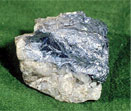Newfoundland and Labrador has a varied selection of metallic minerals. The following is a small representation of this selection. They depict the quality of collectible metallic minerals available in Newfoundland and Labrador. All photographs by James Butler. The small images are linked to full sized photographs with more detail, but will take some time to load.
Chalcopyrite
Chalcopyrite (CuFeS2), a copper-iron sulphide, is the most widespread copper mineral, and one of the most important sources of that metal. The specimen shown in the photo is chalcopyrite owned by Mort Verbiski. It is from the Buchans area.
Chalcopyrite is formed under a great variety of conditions. Most sulphide ore deposits contain some chalcopyrite. It is associated with other minerals such as sphalerite, galena, cassiterite and pyrite.
Numerous showings of chalcopyrite have been recorded from Newfoundland and Labrador. It was mined at several places on the Baie Verte Peninsula (Tilt Cove, Rambler) and in the Springdale area (Whalesback, Gullbridge) as well as a by-product of the mine at Buchans. Numerous showings have been recorded on the island as well as in Labrador.
Gold
Gold (Au) is a precious metal used in jewelry. It has many industrial and medical applications. The photo on the left contains a specimen of gold in quartz vein is from an unknown location in Newfoundland. This sample is owned by the Provincial Museum.
The photo in the middle and on the right show two specimens of gold from the Baie Verte Peninsula. Samples were provided by Brian Dalton and Paul Crocker.
Gold generally occurs in a native state, i.e., it only rarely forms compounds with other minerals such as tellurium. Most gold is commonly found in quartz veins in association with pyrite and other sulphides. Visible gold is rare and most gold is detected by chemical analysis.
In Newfoundland, gold is produced by Anaconda Mining Inc. and Rambler Metals and Mining Canada from their operations on the Baie Verte Peninsula.
Hematite
Hematite (Fe2O3) is an iron oxide and it is the most important and widely used source mineral for iron. Good quality specimens are also used as a semi-precious gemstone, Alaska Black Diamond. The photograph shows micaeous hematite from Wabush, Labrador. It is from the MUN Collection, sample 0241.
Hematite is frequently found as an accessory in igneous rocks and may be associated with magnetite in special circumstances. Some huge deposits of hematite are of sedimentary origin.
Newfoundland has been a major supplier of iron to the world markets for a long time. From about 1895 until the mines closed in the early 1960’s sedimentary iron ore was mined on Bell Island.
Today, all iron production in the province is from the metamorphosed deposits in the Labrador Trough, centered in the towns of Wabush-Labrador City.
Molybdenite
Molybdenite (MoS2), commonly called “Moly”, is a molybdenum sulphide that is the principal source of molybdenum. The sample shown is from a granite body in the Bay d’Espoir area of southern Newfoundland. It is from the Steven V. Papezik Collection, MUN.
Molybdenite is the most common molybdenum mineral and is found as an accessory in some granites. It also occurs with other mineralization, such as scheelite, wolframite, topaz, copper and fluorite. Molybdenum has many applications as a special steel alloy.
Although not mined in Newfoundland and Labrador, molybdenite is associated with the Rencontre Lake area of the Ackley Granite of southern Newfoundland.
Native Copper
Native copper (Cu) is the naturally occurring elemental form of copper. Copper was one of the first metals used by man. It has many uses and in the home water pipes and electrical wires are made from copper. The photograph shows a typical sample of native copper. This sample is owned by the Provincial Museum.
Native copper is most commonly associated with basic extrusive igneous rocks, particularly in the Keweenaw Peninsula of Michigan in the United States. Native copper is also common in the Bay of Fundy region of Nova Scotia. It is usually associated with other copper-bearing minerals such as chalcocite and bornite.
Most occurrences of native copper in our province are found in the Seal Lake area of central Labrador.
Pyrite
Pyrite (FeS2) is an iron sulphide that commonly has a pronounced cubic structure with striated surfaces. It is found in almost any type of geological environment. Sometimes it is mistaken for gold, because of its yellow colour, hence the name “Fool’s Gold”..
The pyrite in the photo on the left show the typical cubic structure of the mineral. The samples are from Catalina, Trinity Bay, and are owned by Loretta Crisby-Whittle. The sample on the right is part of the host mineral for the gold deposits at Royal Oak Mines, Hope Brook.
Pyrite is by far the most common and widespread sulphide mineral. It is found in almost any geological environment. It is rarely of economic importance itself, but its presence calls attention to areas that may contain important economic minerals.
Sphalerite
Sphalerite (Zn,FeS) is a zinc sulphide that supplies the bulk of the world’s supply of zinc. This sample of sphalerite (brown mineral) is from Daniel’s Harbour, Great Northern Peninsula. It is owned by the Provincial Museum.
Sphalerite is usually found in association with galena in the most important deposits of these metals. It can also be associated with chalcopyrite, pyrite, pyrrhotite and magnetite. The world’s annual production of cadmium is obtained as a by-product of the zinc smelting process.
In Newfoundland, sphalerite has been mined at a number of locations, including Buchans, in association with galena and chalcopyrite, and at Daniel’s Harbour, on the Great Northern Peninsula, which was a “Mississippi Valley-type” deposit and had cadmium as a by-product.










